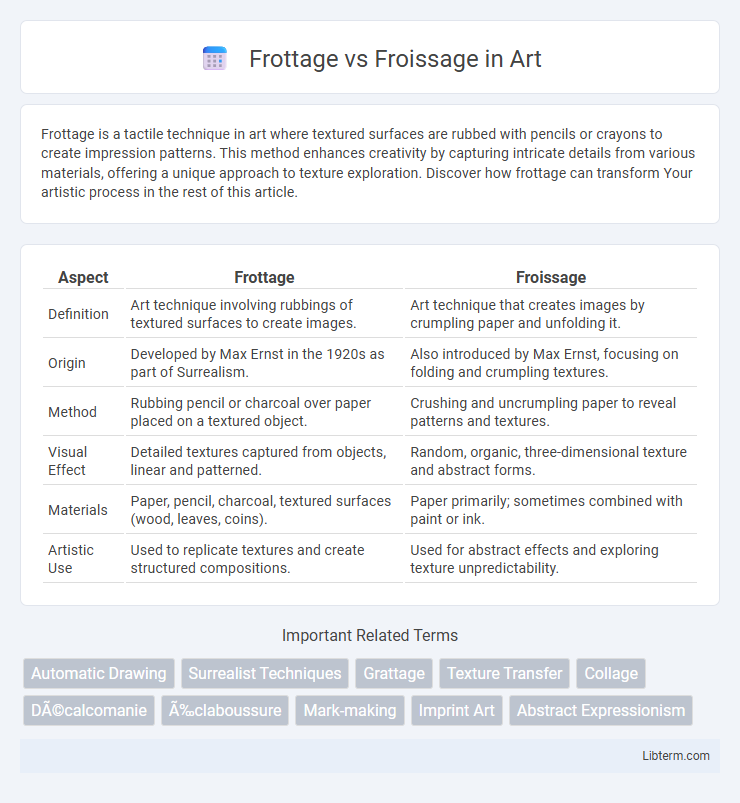Frottage is a tactile technique in art where textured surfaces are rubbed with pencils or crayons to create impression patterns. This method enhances creativity by capturing intricate details from various materials, offering a unique approach to texture exploration. Discover how frottage can transform Your artistic process in the rest of this article.
Table of Comparison
| Aspect | Frottage | Froissage |
|---|---|---|
| Definition | Art technique involving rubbings of textured surfaces to create images. | Art technique that creates images by crumpling paper and unfolding it. |
| Origin | Developed by Max Ernst in the 1920s as part of Surrealism. | Also introduced by Max Ernst, focusing on folding and crumpling textures. |
| Method | Rubbing pencil or charcoal over paper placed on a textured object. | Crushing and uncrumpling paper to reveal patterns and textures. |
| Visual Effect | Detailed textures captured from objects, linear and patterned. | Random, organic, three-dimensional texture and abstract forms. |
| Materials | Paper, pencil, charcoal, textured surfaces (wood, leaves, coins). | Paper primarily; sometimes combined with paint or ink. |
| Artistic Use | Used to replicate textures and create structured compositions. | Used for abstract effects and exploring texture unpredictability. |
Introduction to Frottage and Froissage
Frottage involves creating textured images by rubbing a pencil or crayon over paper placed on a textured surface, capturing the patterns beneath. Froissage, by contrast, involves crumpling or crinkling paper to produce a three-dimensional effect that emphasizes texture and light interplay. Both techniques are foundational in experimental art for exploring texture and surface manipulation.
Defining Frottage: Technique and Origins
Frottage is a surrealist art technique developed by Max Ernst in the 1920s that involves creating textures and patterns by rubbing a pencil or crayon over paper placed on textured surfaces. The technique captures the underlying structure of objects such as wood grain, fabrics, or leaves, producing spontaneous and abstract forms. Originating from the German word "frotten," meaning "to rub," Frottage emphasizes chance and subconscious association in visual art creation.
Understanding Froissage: History and Method
Froissage is an artistic technique that involves crumpling paper to create textured, three-dimensional surface effects, originating in early 20th-century European avant-garde movements. This method contrasts with frottage, which entails rubbing a pencil or charcoal over a textured surface to capture its pattern on paper. Froissage's history is closely linked to artists like Max Ernst, who pioneered both frottage and froissage to explore chance textures and abstract compositions within surrealist art.
Key Differences Between Frottage and Froissage
Frottage involves creating textures by rubbing a pencil or crayon over paper placed on a textured surface, emphasizing transferred patterns, whereas Froissage is the art of crumpling paper to produce intricate creases and three-dimensional textures. Frottage captures the relief details of objects, making it primarily a drawing technique, while Froissage relies on physical manipulation of the paper, resulting in sculptural forms. Both techniques explore texture uniquely, with Frottage focusing on surface impressions and Froissage on volumetric expression.
Artistic Movements Influencing Frottage
Frottage, pioneered by Max Ernst in the Surrealist movement, draws heavily on automatism and spontaneous creation to explore subconscious imagery through textured rubbings. Froissage, while also linked to Surrealism, incorporates Cubist fragmentation and Abstract Expressionism by manipulating crumpled paper to produce layered, dynamic compositions. Both techniques reflect the avant-garde's interest in disrupting traditional artistic processes to reveal hidden depths and new visual realities.
Notable Artists Who Popularized Froissage
Notable artists who popularized Froissage include the Czech artist Ladislav Novak, whose innovative techniques in the mid-20th century brought international attention to this textural paper art form. Novak's integration of Froissage into surrealist and abstract compositions highlighted its expressive potential beyond traditional frottage. Froissage evolved as a complementary technique to Max Ernst's frottage, expanding the experimental vocabulary of post-war modernism.
Materials and Tools Used in Each Technique
Frottage involves placing paper over textured surfaces like wood, leaves, or coins, then rubbing graphite, charcoal, or pencil to capture the underlying patterns, demanding only simple tools like paper and drawing media. Froissage, by contrast, requires thin, flexible paper that can be crumpled and manipulated to create layered, three-dimensional textures, often enhanced with ink, watercolor, or pastel for added visual depth. Both techniques emphasize different materials and tools: frottage prioritizes texture transfer through rubbing mediums on rigid surfaces, while froissage centers on sculptural paper manipulation combined with various coloring agents.
Aesthetic Outcomes: Frottage vs Froissage
Frottage creates textured surfaces by rubbing a pencil or crayon over paper placed on a rough object, resulting in detailed, linear patterns that emphasize surface structure and organic forms. Froissage involves crumpling and unfolding paper to produce irregular creases and tactile reliefs, yielding abstract and sculptural aesthetics with dynamic depth. Comparing frottage and froissage highlights frottage's emphasis on surface texture reproduction versus froissage's focus on three-dimensional, expressive distortion of the medium.
Modern Applications in Contemporary Art
Frottage and froissage are both textural techniques widely used in contemporary art to create layered, tactile surfaces that enhance visual depth and narrative complexity. Modern artists employ frottage by rubbing pencil or charcoal over textured objects to capture intricate patterns, while froissage involves crumpling paper to produce three-dimensional forms that emphasize materiality and spontaneity. These methods allow for innovative expressions in mixed media, installation art, and experimental painting, fostering dynamic interactions between texture, light, and shadow.
Choosing the Right Technique for Your Artwork
Frottage involves creating texture by rubbing a pencil or crayon over a textured surface, capturing its intricate details on paper, while froissage uses the crumpling and unfolding of paper to produce unique, three-dimensional patterns and shadows. Choosing the right technique depends on the desired effect: frottage is ideal for detailed, tactile textures that emphasize surface patterns, whereas froissage adds depth and organic complexity through its sculptural qualities. Artists seeking precise texture replication prefer frottage, while those aiming for abstract forms and dynamic light play gravitate toward froissage.
Frottage Infographic

 libterm.com
libterm.com